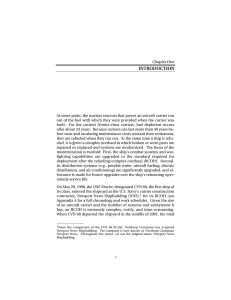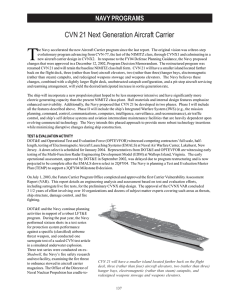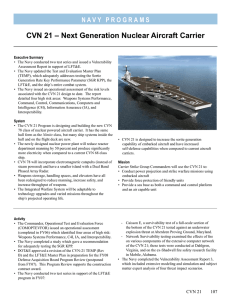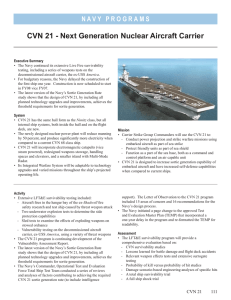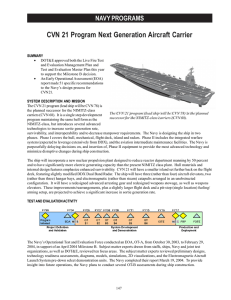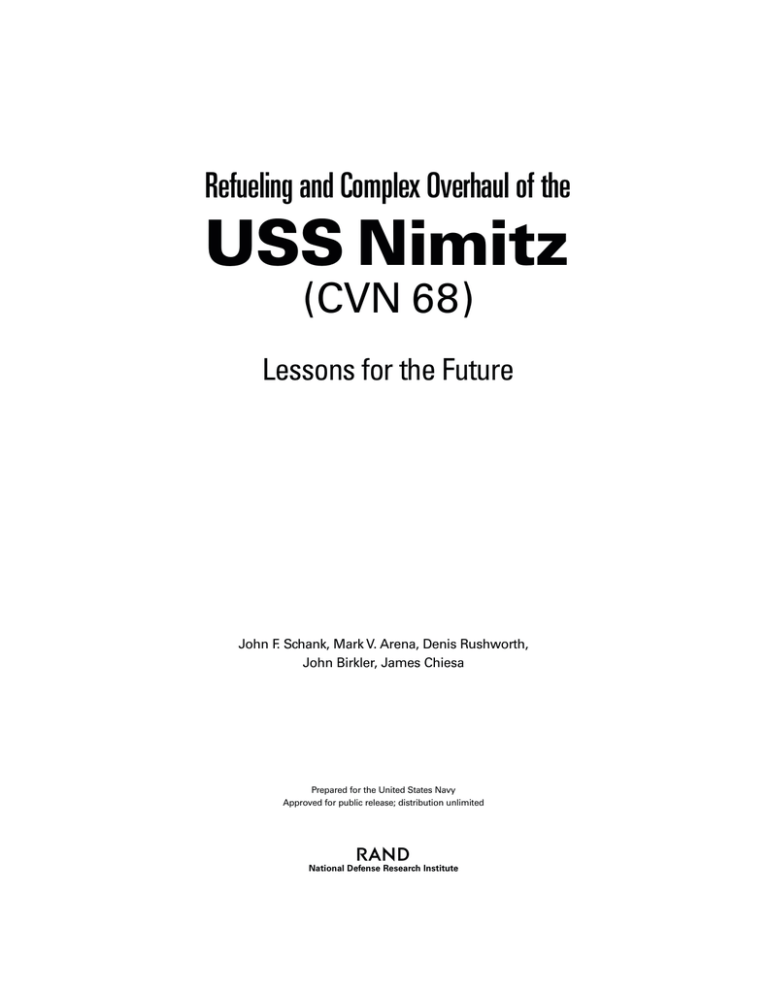
Refueling and Complex Overhaul of the
USS Nimitz
(CVN 68)
Lessons for the Future
John F. Schank, Mark V. Arena, Denis Rushworth,
John Birkler, James Chiesa
Prepared for the United States Navy
Approved for public release; distribution unlimited
R
National Defense Research Institute
The research described in this report was conducted for the U.S.
Navy within the Acquisition and Technology Policy Center of RAND’s
National Defense Research Institute, a federally funded research and
development center supported by the Office of the Secretary of
Defense, the Joint Staff, the unified commands, and the defense
agencies under Contract DASW01-01-C-0004.
Library of Congress Cataloging-in-Publication Data
Planning and executing the refueling and complex overhaul of the USS Nimitz
(CVN 68) : lessons for the future / John F. Schank ... [et al.].
p. cm.
“MR-1632.”
Includes bibliographical references.
ISBN 0-8330-3288-7
1. Nimitz (Ship : CVN-68) 2. Nuclear aircraft carriers—United States—
Maintenance and repair. 3. Marine nuclear reactor plants—United States—
Maintenance and repair. I. Schank, John F. (John Frederic), 1946–
VA65.N625 P53 2002
359.9'4835—dc21
2002035781
RAND is a nonprofit institution that helps improve policy and
decisionmaking through research and analysis. RAND ® is a
registered trademark. RAND’s publications do not necessarily reflect
the opinions or policies of its research sponsors.
© Copyright 2002 RAND
All rights reserved. No part of this book may be reproduced in any
form by any electronic or mechanical means (including
photocopying, recording, or information storage and retrieval)
without permission in writing from RAND.
Published 2002 by RAND
1700 Main Street, P.O. Box 2138, Santa Monica, CA 90407-2138
1200 South Hayes Street, Arlington, VA 22202-5050
201 North Craig Street, Suite 202, Pittsburgh, PA 15213-1516
RAND URL: http://www.rand.org/
To order RAND documents or to obtain additional information,
contact Distribution Services: Telephone: (310) 451-7002;
Fax: (310) 451-6915; Email: order@rand.org
PREFACE
In May 1998, the USS Nimitz (CVN 68) entered Newport News Shipbuilding to begin its midlife refueling/complex overhaul (RCOH). In
the RCOH, the nuclear reactor was refueled, and significant portions
of the ship’s structure, systems, and subsystems were repaired or
upgraded with transformational technologies enabling the aircraft
carrier to adapt to future changes in warfare doctrine and national
defense policy. The CVN 68 RCOH was the first for the Nimitz class
and only the fourth ever accomplished on a nuclear aircraft carrier
(the USS Enterprise, CVN 65, has undergone three RCOHs). The Ship
Construction, Navy (SCN) funding for the planning and execution of
this complex project totaled approximately $2.2 billion. The project
took five years of planning and three years of execution to complete.
As a result of numerous changes to the budget and work requirements and a four-month labor-union strike during the overhaul, the
scheduled completion of the project slipped by several months and
the cost grew over the contracted value. Since there are nine more
ships in the class that will receive RCOHs in the future, the Program
Executive Officer (PEO) Aircraft Carriers requested that RAND analyze the planning and execution of the CVN 68 RCOH and identify
changes in processes and procedures that would lead to better cost
and schedule performance for the remaining Nimitz-class RCOHs.
The research had three main objectives:
•
To identify and quantify the differences between the initial cost
and schedule expectations and the final results of the USS Nimitz
RCOH.
iii
iv
Refueling and Complex Overhaul of the USS Nimitz (CVN 68)
•
To understand the various factors that influenced the cost and
schedule differences.
•
To identify possible changes to planning and execution procedures that would improve the performance of future Nimitzclass RCOHs.
This report describes the research results of these tasks. Most of the
recommendations and process improvements have already been
implemented with positive results.
The research documented in this report was carried out within the
Acquisition and Technology Policy Center of RAND’s National
Defense Research Institute, a federally funded research and development center sponsored by the Office of the Secretary of Defense, the
Joint Staff, the unified commands, and the defense agencies.
CONTENTS
Preface .........................................
iii
Figures .........................................
ix
Tables..........................................
xi
Summary .......................................
xiii
Acknowledgments.................................
xxv
Acronyms and Abbreviations ......................... xxvii
Chapter One
INTRODUCTION ..............................
Chapter Two
BACKGROUND................................
Institutional Framework .........................
Program Executive Officer ......................
Naval Nuclear Propulsion Program ...............
Naval Sea Systems Command ...................
Newport News Shipbuilding ....................
Ship’s Force.................................
Type Commander ............................
Challenges ...................................
Budgetary Uncertainties .......................
Sources of Uncertainty with the Ship and in the Yard ..
Challenges Arising from the Number of Parties
Involved .................................
Internal Staffing Challenges .....................
Changing Maintenance and Administrative Contexts ..
v
1
5
5
5
6
8
8
9
10
10
10
11
13
14
15
vi
Refueling and Complex Overhaul of the USS Nimitz (CVN 68)
Chapter Three
BUDGETING, PLANNING, AND CONTRACTING FOR
THE RCOH ...................................
Budgeting ....................................
Planning .....................................
Nuclear Work................................
Nonnuclear Modernization .....................
Nonnuclear Repair ...........................
Contracting...................................
Contract Modifications ..........................
17
17
19
20
21
22
23
26
Chapter Four
COST GROWTH ...............................
Definition of RCOH Costs ........................
Overall Growth ................................
Sources of Cost Growth ..........................
Increase in Labor Hours and Costs ................
Increase in Overhead Costs .....................
Increase in Material Costs ......................
Nuclear Versus Nonnuclear Cost Growth .............
Overtime Use .................................
Field Modification Requisitions ....................
31
32
34
35
37
40
41
42
43
44
Chapter Five
ASSESSING THE PLANNING AND EXECUTION
PROCESSES ..................................
Criterion 1: Lines of Authority .....................
Background .................................
Planning ...................................
Negotiating the Contract .......................
Execution ..................................
Criterion 2: Communication ......................
Criterion 3: Cost, Schedule, and Change Control .......
Criterion 4: Risk Management.....................
Criterion 5: Work-Package Development .............
Unclear Goal or End Objective ...................
Failure to Include All Necessary Work in the
Authorized AWP and Contractor and
Ship’s Force Work Packages ...................
Inadequately Planned and Integrated Ship’s
Force Work Package.........................
51
54
55
56
58
59
60
63
67
68
70
72
74
Contents
vii
Failure to Consider Subcontracting of Major
Tasks to Reduce Cost ........................
Criterion 6: Cost Estimates .......................
Criterion 7: Incentives ..........................
Criterion 8: Funding ............................
Criterion 9: Management ........................
Summary ....................................
76
77
79
80
81
83
Chapter Six
CONCLUSIONS AND RECOMMENDATIONS..........
Cost and Schedule Growth .......................
Problems in the Planning and Execution Processes .....
Areas for Improvement ..........................
The Planning Process..........................
Data and Estimating Capabilities .................
The Relationship Between the Navy and NNS ........
85
85
87
89
90
92
94
Appendix
A. Chronology and Work Schedule....................
B. The 1999 Strike Against Newport News Shipbuilding ....
C. Commercial Analogs to the RCOH Process ............
97
99
103
FIGURES
3.1. Modernization Work-Package Development
Process ...................................
3.2. Total NNS Contract Cost, by Major Elements .......
3.3. Total NNS Contract Man-Hours, by Category of
Work.....................................
4.1. Components of RCOH Cost ....................
4.2. Breakdown of Cost into Broad Pools, for Negotiated
Settlement and Estimate at Completion ...........
4.3. Breakdown of Cost Growth ....................
4.4. Growth of the Labor Rate in the CVN 68 RCOH......
4.5. Cost Performance Index ......................
4.6. NNS Overhead Rate .........................
4.7. Cost Growth: Percentage Change, June 2001 Cost
Report vs. Negotiated Settlement ................
4.8. Expenditures Generated by FMRs, by Quarter ......
4.9. Nuclear and Nonnuclear Expenditures Generated
by FMRs, by Quarter .........................
C.1. An Illustrative Assessment Tool: AP-Network’s
Readiness Assessment Pyramid for Turnarounds ....
ix
22
25
25
32
34
37
38
39
40
43
46
47
111
TABLES
3.1.
3.2.
3.3.
3.4.
4.1.
4.2.
4.3.
4.4.
4.5.
4.6.
5.1.
5.2.
5.3.
5.4.
5.5.
5.6.
5.7.
5.8.
Budget History for the CVN 68 RCOH.............
CVN 68 RCOH Execution Contract Man-Hours .....
CVN 68 RCOH Contract P-Modifications ..........
CVN 68 RCOH Contract A-Modifications ..........
Breakdown of Cost into Broad Pools, for Negotiated
Settlement and Estimate at Completion ...........
Changes in the Costs of Labor, Materials, Overhead,
Etc., with Strike Costs Omitted..................
Ratio of Nuclear and Nonnuclear Work Costs in the
June 2001 Cost Report to Those in the Negotiated
Settlement ................................
Growth in Straight Time and Overtime............
Top Ten SWLINs Reimbursed in Response to FMRs ..
FMRs, by Ship Component ....................
Achievement Levels for the Lines-of-Authority
Criterion ..................................
Achievement Levels for the Communication
Criterion ..................................
Achievement Levels for the Cost, Schedule, and
Change-Control Criterion .....................
Achievement Levels for the Risk-Management
Criterion ..................................
Achievement Levels for the Work-Package
Development Criterion .......................
Achievement Levels for the Cost-Estimates
Criterion ..................................
Achievement Levels for the Incentives Criterion .....
Achievement Levels for the Funding Criterion ......
xi
18
24
28
29
35
36
42
44
48
49
54
61
64
67
69
77
79
80
xii
Refueling and Complex Overhaul of the USS Nimitz (CVN 68)
5.9. Achievement Levels for the Management Criterion ..
5.10. Summary of Program Assessments ..............
C.1. Comparison of Commercial Plant Turnarounds and
RCOHs ...................................
82
83
106
SUMMARY
All Nimitz-class aircraft carriers are scheduled to undergo reactor
refueling and complex overhauls (RCOHs) at around 23 years of age.
The USS Nimitz (CVN 68), the first ship of its class, went through its
RCOH between 1998 and 2001 at Newport News Shipbuilding (NNS).
The total contract value for the execution of this project was approximately $1.5 billion, some $250 million more than the original contract value. The project was scheduled to last 33 months, but it took
several months longer to complete. How much of the cost could
properly be interpreted as growth over the budgeted amount? What
were the sources of that growth? In what ways did planning and execution management fall short of the ideal? Answers to questions
such as these should help in managing future RCOHs, which will
have to meet more exacting budgetary limits.
BACKGROUND
A carrier RCOH may be the most challenging engineering and industrial task undertaken anywhere by any organization. Not only
must the onboard reactor be refueled, a variety of maintenance and
repair actions must also be undertaken, all while the entire ship is
being modernized. Modernization includes upgrading the ship’s
combat system and other warfighting capabilities and upgrading
such distributed systems as potable water, electrical power, aircraft
refueling, and air conditioning.
At the start of the CVN 68 RCOH, the Navy was aware of additional
challenges compounding the difficulty of the task that lay ahead:
xiii
xiv
Refueling and Complex Overhaul of the USS Nimitz (CVN 68)
•
The planning effort was complicated by volatility in the amount
budgeted for RCOH execution. It was also hampered by the need
for the ship to continue operating, which constrained the degree
to which systems could be disassembled and inspected to assess
repair needs.
•
Emergent defense needs might make it necessary to divert RCOH
funds.
•
The RCOH management staff was small and would experience
turnover during the long course of RCOH planning and execution. Also, the primary organization involved with carrier availabilities, Planning and Engineering for Repairs and Alterations–
Carriers (PERA-CV), was dissolved through base realignment and
closure (BRAC) actions prior to the start of planning.
•
The contractor was accustomed to more-predictable newconstruction projects.
•
Various organizations with potentially different objectives had a
stake in the RCOH process and outcome.
Despite the difficulties, many aspects of the RCOH were successful.
The overhaul significantly improved the ship’s material condition.
The Navy and the contractor did an excellent job of managing the
funds and time available during the last year of the overhaul. The
shipyard, ship’s force, and subcontractors accomplished more than a
million man-hours of unplanned work authorized by the government only eight months before delivery. The Navy and the contractor improved methods of sharing financial data and communicating
to support just-in-time decisionmaking. In addition, both the Navy
and the contractor learned from the CVN 68 experience and made
substantial improvements in planning and execution for the CVN 69
and CVN 70 RCOHs. These improvements on the CVN 69 RCOH
include the following:
•
Reduction of the work-package development and advanceplanning phase from five years to four years by stabilizing budgets, developing reusable planning products, and building an
experienced workforce to accomplish these tasks.
•
Use of integrated product and process development, which
allowed significantly more type commander (TYCOM) involve-
Summary
xv
ment in the development of the work package and more contractor involvement in job-scope planning.
•
Prestaging of critical equipment such as propellers and generator
rotors, which reduced cost and schedule uncertainties associated
with the open-and-inspect strategies used on CVN 68.
•
Better job-scope development, which allowed entry into the CVN
69 execution contract with only 14 “Class F” estimates (in which
the cost of the job can be estimated only to within +/–40 percent
due to limited understanding of the job scope), as compared
with more than 90 on CVN 68.
•
Tighter management of the emergent and supplemental-growth
pool, based on weekly metrics.
•
Improved efficiency of the contractor workforce resulting from
improved cost-accounting procedures and weekly reviews of
expenditures with cost-account managers.
Specific examples of improvements new to the CVN 70 RCOH planning process include the following:
•
A new emphasis on strategic planning, which strikes right at the
heart of workload forecasting, perhaps the biggest cost driver in
the shipbuilding industry. By looking at long-range workforce,
facilities, and schedule requirements for aircraft carriers, surface
ships, and submarines, the Navy is making early modifications
to overhaul schedules, preventing unexpected business-base
changes, which drive up overhead costs.
•
A new contracting strategy based on the development of discrete
annual planning packages that allow the contractor to complete
specific tasks during each of the advance-planning years. This is
reducing the cost of ship checks and drawing development and
will provide a better understanding of the cost of work prior to
the start of an RCOH.
•
A new modernization strategy, which installs approved ship
alterations (rather than engineering-change proposals, as in the
new-construction vernacular). This strategy will improve configuration control and logistics supportability and will reduce
life-cycle costs by creating more reusable planning products.
xvi
•
Refueling and Complex Overhaul of the USS Nimitz (CVN 68)
A new work-assignment strategy that maximizes the use of
customer-contracted teams whose familiarity with certain new
technologies will provide higher-quality work at a reduced cost.
The problem-oriented emphasis in this report stems from our objective, which was to find ways to improve planning and execution processes. It should not be interpreted to imply that more was wrong
with the RCOH than was right with it.
COST GROWTH
We restricted our investigation of cost growth to the NNS execution
contract (ignoring planning costs, government-furnished equipment
(GFE), etc.). Even with this restriction, identifying the amount of cost
growth over budget is not as straightforward as it might seem, because there is no irrefutable view as to what should be counted in the
base and what in the increment.
At the outset of RCOH execution, the Navy and NNS agreed to a price
of $1.22 billion for a well-defined basic work package. That total covered 16.2 million labor hours. The expectation by the summer of
2000 was that the total labor input would ultimately reach 20.9 million hours, a labor-hour growth of 29 percent.
The base negotiated settlement, however, did not include allowances
for emergent and supplemental (E&S) costs and for small-value
changes (SVCs). These allowances could reasonably have been included in the base, particularly considering that some difficult-tocost tasks were deliberately put in the E&S pool at the outset and that
NNS would incur no profit penalty by using up the allowances. With
the allowances, the negotiated settlement covered 19.4 million labor
hours, suggesting a growth of 7.7 percent. Furthermore, about onefifth of that could be attributed to inefficiencies associated with a
union-labor strike in mid-1999. Since our purpose is to enlighten
future planning, it seems inappropriate to include strike-related
growth, as strikes at NNS are infrequent. A labor-hour growth estimate closer to 6 percent would thus be justified.
This modest 6 percent labor-hour growth translated into a substantial cost growth, 17 percent, because the labor rate also grew slightly
and the overhead rate came in 10 percentage points above what had
Summary
xvii
been expected. The compounded effect was a total labor cost growth
of 12 percent; the remainder (of the 17 percent) was the result of an
almost one-third increase in material costs. (The material cost increase was due to the addition of work items to the package and to an
underestimate of subcontract costs, which are included in the material budget.)
Labor hours and overhead rates increased for many reasons, but we
cannot confidently infer the specific causes, or contributions, to the
increased costs. We can, however, identify multiple problems in
RCOH planning and execution management that could have contributed not only to higher costs but also to schedule slippage. These
difficulties were most apparent in the nonnuclear repair and modernization tasks.
PROBLEMS IN PLANNING AND EXECUTION
Planning for the nonnuclear aspects of the CVN 68 RCOH was characterized by problems of several types. First, not all parties with a
stake in the outcome had sufficient input. The stakeholders included
the Aircraft Carrier Program Office (specifically, PMS 312); the
TYCOM (the commander of the aviation forces in the Pacific Fleet in
this case); the Naval Sea Systems Command (NAVSEA) Supervisor of
Shipbuilding, Conversion, and Repair (SUPSHIP) at the NNS site;
and NNS itself.
Because PERA-CV, the field agency of PEO Aircraft Carriers most
knowledgeable about carrier availabilities, had been dissolved, PMS
312 assumed responsibility from the outset for developing the nonnuclear repair portion of the work package and retained substantial
authority during execution. This was problematic because that office’s focus has not traditionally been on waterfront issues. The
TYCOM is the ship’s “owner” and has the biggest stake in seeing that
it emerges from the RCOH able to accomplish its missions. The
TYCOM was involved throughout the CVA 68 RCOH planning and
execution process, but most heavily in the early planning stages,
when TYCOM personnel provided information on the material
condition of the ship and on the types of repairs they believed would
be needed. However, as planning progressed, the TYCOM’s role
diminished and, in that office’s opinion, it was given little authority
in the continuing development of the work package.
xviii
Refueling and Complex Overhaul of the USS Nimitz (CVN 68)
SUPSHIP NN Code 1800, the organization where some of the PERACV analysts were ultimately assigned, did not become involved in
planning until two years into the process. It eventually did play a key
role in developing the work package that was included with the request for proposal (RFP) for RCOH execution. NNS did not participate as much as it possibly could have during development of the
nonnuclear work package, despite having built all of the Navy’s
nuclear-powered aircraft carriers and having accomplished a number of carrier availabilities, including RCOHs for CVN 65.
NNS did provide initial estimates of the costs of the tasks contained
in the work package. No Navy office, however, had adequate staff to
bring the Navy’s 50 years of experience in constructing and maintaining large-deck carriers to bear in a timely manner to provide independent cost estimates that could serve as a check on NNS’s numbers.
The relationship between planning and budgeting was problematic.
While planning was under way, the top-line budget number for the
RCOH was moving up or down—mostly down—in response to both
perceived RCOH needs and unrelated demands for funds elsewhere
in the Department of Defense (DoD). The planning process could
not react quickly enough to this budget volatility. As a result, the development of the work package was not directly tied to the available
budget.
It did not help that NNS responded to the RFP with a proposal having
a cost greater than that suggested by the initial estimates it had provided to the Navy. Navy and NNS negotiators thus faced the challenge of shaping the work package to fit the available budget. The
challenge was all the more difficult because Navy stakeholders had
not reached an internal consensus regarding the goals of the RCOH.
The early planning goal of a ship equivalent in capability to a new
one had been rejected as unrealistic but had not been replaced with
a new consensus. Not coincidentally, no priorities had been established for deciding which tasks to drop should costs turn out higher
(or the budget lower) than expected. The result was uncoordinated
triage and ad hoc workarounds, such as the decision to pay for predictable tasks (e.g., the painting of tanks) with funds intended for
unpredictable work. That decision virtually guaranteed that money
Summary
xix
for unpredictable work would be tight, approvals would be delayed,
and overruns would occur.
During execution, any change to tasks in the basic work package, any
SVCs, and any work to be paid out of E&S funds had to be the subject
of a field modification requisition (FMR) from SUPSHIP NN. Budgetary problems aside, the complex nature of an RCOH results in
many requests for change in the basic work package’s task list as execution progresses. However, because work on the CVN 68 RCOH
that could have been predicted had been placed in the E&S pool,
many more FMRs for additions to the approved task list were made
than would have been expected. Another factor driving up the FMR
count was the lack of a clear understanding of the material condition of the ship. The numerous FMRs overwhelmed personnel at
SUPSHIP NN, whose staff for managing the RCOH was no larger than
that for overseeing an availability an order of magnitude smaller.
As the RCOH neared completion, additional funding became available to compensate for strike costs and to support growth in E&S
work. A large number of changes, previously shelved for lack of
funds, were approved. This influx of work caused NNS problems in
managing its workforce, not only on the RCOH but also for other
projects in the shipyard. Overtime was needed to maintain schedules, and some inefficiency resulted.
Navy management of the RCOH was hampered by a lack of timely,
accurate, and useful data from NNS on the progress of the repairs
and the estimated costs at completion. Progress-related data were
received at least three months late and were often displayed in a
manner that was confusing and unhelpful for Navy project managers. Furthermore, a change in the data-collection and management system within NNS resulted in some needed data being
unavailable or inaccurate.
The complexities of RCOH management were exacerbated by the
fact that NNS’s labor force was not the only one working on the ship.
A large Navy crew was assigned to the carrier throughout the RCOH
and was responsible for carrying out part of the work package. Coordination between the two labor forces was complicated by their
use of different task identification systems and was the responsibility
of only two persons on the waterfront. Coordination failures, as well
xx
Refueling and Complex Overhaul of the USS Nimitz (CVN 68)
as the inexperience of the ship’s force at some tasks, resulted in
rework by both NNS and the ship’s force.
AREAS FOR IMPROVEMENT
In addition to the improvements to planning and execution that have
already been made for the CVN 69 and 70 RCOHs, we suggest that
the following three sets of actions be taken.
Improve the Planning Process
Effective planning is critical to the success of an RCOH. It is important to involve knowledgeable people and organizations early. These
organizations include, at least, SUPSHIP NN Code 1800 (especially
the personnel from the PERA-CV organization), the TYCOM, and
NNS.
NNS is the organization that will execute a major portion of the total
work package for future RCOHs, and it is the one that has practical
experience with large-carrier availabilities. Thus, its expertise and
knowledge should be used not only in the development of the nuclear repair package, as is now the case, but also in identifying specific tasks that should be in the nonnuclear repair package.
The above organizations should work together to develop a list of
tasks for possible inclusion in the work package of each RCOH. This
list should be general in nature and should cover all potential tasks.
Such a list could form the basis for determining what should be included in the work package for each RCOH. The list could be refined
with each successive RCOH.
Each task should have a priority established. The highest priority
would be given to tasks that must be accomplished during the RCOH.
The lowest would indicate tasks that could be done if budget were
available but that could also be deferred without degrading the ship’s
safety or operating capability. Costs should be developed for each
task to permit priority-driven revision of the task list should budgets
turn out to be lower than expected.
Finally, the planning for each task should include some understanding of the task’s relationship with others on the list. Performing one
Summary
xxi
task may require that another task also be accomplished. Or, if one
task, such as replacing a major component, is not included, another
task, such as repairing that component, may be required.
The participation of the organizations involved in planning should
not stop with the development of the work package. Navy organizations, such as the TYCOM and SUPSHIP NN, should prioritize tasks
in the work package and advise on the actions to take during budget
negotiation and contracting if budgets turn out to be constrained or
if tasks must be removed from the package.
Improve Data and Estimating Capabilities
Useful data and effective forecasting capabilities are essential for
successfully planning and executing an RCOH. During planning, to
formulate a work package, it is necessary to have historical availability data on the Nimitz class and on the specific carrier scheduled for
RCOH. A database of task labor and material costs agreed upon by
the Navy and NNS would also help in prioritization, as described
above.
During RCOH execution, timely, useful, and accurate data are
needed to evaluate the current cost and schedule status of the RCOH.
These data should have sufficient detail that all elements of a specific
task are easily identifiable from an overall integrated plan that covers
numerous tasks. Forecasting methods are needed to project the cost
at, and the timing of, completion. PMS 312 must also establish processes and criteria for informed decisionmaking during RCOH execution, when inspections result in FMRs for increases in work and
costs.
In general, NNS should freely share with the Navy those data required for effective planning and execution. For example, the Navy
should be able to see the basis for the man-hour estimates to accomplish a specific task. The Navy must, of course, understand the
business-sensitive nature of the data. It must protect against any
possible misuse, especially if any of the data are pertinent to projects
for which NNS must compete with other contractors, and some data
should remain private.
xxii
Refueling and Complex Overhaul of the USS Nimitz (CVN 68)
In an open-book data environment, the Navy would have access to
the same data that are used to formulate the quarterly cost performance reports (CPRs). That would allow the Navy to monitor the
cost and schedule as events transpire and would permit timelier
decisionmaking.
Improve the Relationship Between the Navy and NNS
During the CVN 68 RCOH, the relationship between the Navy and
NNS was strained. Many in the Navy expressed mistrust of NNS, believing the contractor at times withheld information that would have
been useful for RCOH planning and execution. This problem must
be resolved for subsequent RCOHs. The Navy and NNS must have
more confidence in each other and must work more closely together
during both planning and execution. They must commit to a longterm relationship with mutually agreed-upon objectives and effective communication strategies that lead to openness and trust.
The path to a better relationship is not one we can map out here.
The two organizations might consider assigning employees to each
other’s offices for periods of time. This is a technique often used by
U.S. military services in their interactions with the militaries of other
nations. However it is established, a solid, professional relationship
between the Navy and NNS is needed to successfully plan and execute the remaining RCOHs for the Nimitz-class ships.
SPECIFIC RECOMMENDATIONS
In light of our study findings, we recommend that the Navy take the
following specific actions:
•
Develop flexible, effective contract-negotiating processes. The
current process is too rigid, subject to manipulation, and likely to
result in lose-lose rather than win-win outcomes.
•
Establish RCOH goals that are clear enough to form a baseline
repair package that is consistent with the budget and that is well
supported by (and communicated to) all carrier stakeholders.
•
Collaborate with NNS to improve Navy-contractor communications, broadly considered. In particular, establish metrics to en-
Summary xxiii
able senior managers to make accurate, timely assessments of
RCOH progress.
•
Reduce the rotation rates of Navy program-office and shipyard
managers to improve continuity and RCOH experience.
•
Improve the efficiency of contract-change management, i.e., the
ability of the shipyard and the Navy to identify, fund, and contract new work. To achieve this goal, NNS may have to assume
more risk in the execution of RCOHs.
ACKNOWLEDGMENTS
This research could not have been accomplished without the assistance of many individuals. RADM (Ret.) Roland Knapp, then Program Executive Officer (PEO) Aircraft Carriers, and Brian Persons, his
deputy, supported and encouraged the work. Many other individuals
in PEO Aircraft Carriers willingly shared their time and their
knowledge of the CVN 68 RCOH planning and execution process. These include CAPT Chuck Bush, CAPT Mike Schwartz, John
Galloway, Wes Corley, Lee Bowersox, and Tina Wujick.
If we were to single out one individual who supported us in extraordinary ways, it would be CDR Ralph Soule, then of SUPSHIP NN.
The time, energy, and insights CDR Soule provided were well beyond
any reasonable expectations. Ben Parish, SUPSHIP NN Code 1800,
also shared his vast knowledge and expertise about aircraft-carrier
availabilities in general and the CVN 68 RCOH planning in particular.
Robert Murphy and Stacy Marcott of the Nuclear Propulsion Directorate of the Naval Sea Systems Command provided information on
the nuclear aspects of the RCOH and offered many constructive
comments during the course of the research. Michael Petters, Roger
Eshelman, and Ken Mahler of Newport News Shipbuilding spent
several sessions with us explaining the roles and functions of
the shipyard during execution and planning. George DeBakey of
AP-Networks provided insights into the turnaround management
process for the commercial sector.
At RAND, Fred Timson aided with the cost analysis, and Debbie
Peetz provided her typically excellent support to the overall research.
xxv
xxvi
Refueling and Complex Overhaul of the USS Nimitz (CVN 68)
Ed Keating and John Halliday offered many valuable suggestions that
strengthened the report.
These individuals helped us with factual information and suggested
some implications. We, however, are solely responsible for the interpretation of this information and the judgments and conclusions
drawn. And, of course, we alone are responsible for any errors.
ACRONYMS AND ABBREVIATIONS
ACO
administrative contract officer
AIRLANT
Naval Aviation, Atlantic Fleet
AIRPAC
Naval Aviation, Pacific Fleet
ALRE
aircraft launch and recovery equipment
APO
assistant project officer
ATR
above-threshold reprogramming
AWP
availability work package
BRAC
base realignment and closure
C4I
command, control, communications,
computers, and intelligence
CAPS
Carrier-Availability Planning System
CARPOP
carrier reactor-plant overhaul package
CAST
carrier-availability support team
CDRL
contract data requirements list
CHT
collection, holding, and transfer
CLA
carriers, littorals, and auxiliaries
CLIN
contract line-item number
CNO
Chief of Naval Operations
COFC
cost of facilities capital
COH
complex overhaul
COMNAVAIRLANT
Commander, Naval Air Forces Atlantic
xxvii
xxviii
Refueling and Complex Overhaul of the USS Nimitz (CVN 68)
COMNAVAIRPAC
Commander, Naval Air Forces Pacific
CPI
cost performance index
CPIF
cost plus incentive fee
CPR
cost performance report
CSMP
current ship’s maintenance plan
CVN
carrier vessel, nuclear
DoD
Department of Defense
E&S
emergent and supplemental
EAC
estimate at completion
EVMS
Earned-Value Management System
FMR
field modification requisition
FY
fiscal year
GFE
government-furnished equipment
GOCO
government-owned, contractor-operated
ICAN
integrated communications and advanced
network
IMP
Incremental Maintenance Program
INSURV
Board of Inspection and Survey
IR
inspection report
JCN
job control number
LOE
level of effort
MMP
modernization ship-design management plan
MPN
Military Personnel, Navy
NAVAIR
Naval Air Systems Command
NAVSEA
Naval Sea Systems Command
NNPP
Naval Nuclear Propulsion Program
NNS
Newport News Shipbuilding
NRRO
Naval Reactors Representative’s Office
O&MN
Operations and Maintenance, Navy
OPN
Other Procurement, Navy
Acronyms
xxix
PCO
procuring contract officer
PEO
Program Executive Officer
PERA-CV
Planning and Engineering for Repairs and
Alterations–Carriers
PMP
Program Management Plan
PSA
post-shakedown availability
RCOH
refueling/complex overhaul
RFP
request for proposal
RPPY
Reactor-Plant Planning Yard
SCA
ship cost adjustment
SCN
Ship Construction, Navy
SDM
ship design manager
SLEP
service-life extension program
SPAWAR
Space and Naval Warfare Command
SRA
selected restricted availability
STA
special transfer authority
SUPSHIP NN
Supervisor of Shipbuilding, Conversion, and
Repair, Newport News
SVC
small-value change
SWLIN
ship work line-item number
TAR
technical analysis and report
TYCOM
type commander

